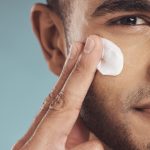Those tiny white bumps that appear on the skin, called milia, can be a source of frustration for many people. While milia are generally benign and not a cause for concern, they can affect your confidence. In this blog, we explain why these tiny white bumps appear on your skin and how to prevent them.
What are milia?
Milia are small, round keratin cysts on the surface of the skin. Keratin is a skin protein that protects the outer layer of your skin, hair and nails.
In a typical skin cycle, dead skin cells made up of keratin naturally slough away to reveal new skin cells. When dead skin cells stay on the surface, new skin can form over the keratin, trapping it beneath the surface.
These small white bumps are often mistaken for whiteheads, but they are not a form of acne. Clogged pores do not cause this condition.
Milia can appear in clusters or on their own. These small cysts are not itchy and should not cause discomfort. The condition is not contagious. It is not the same as keratosis pilaris, which appears as patches of rough skin with red bumps.
Common causes of milia
People of all ages can develop this condition, from infants to adults. It is most commonly found on the cheeks, forehead or under the eyes. Some people develop milia on the chest, arms or legs.
Infants may have neonatal milia, or “milk spots,” around their noses. It is present at birth but generally goes away on its own.
There are several causes of milia in children and adults, including:
Oily lotions
Heavy or oil-based skincare products that clog pores can contribute to milia formation, especially around the eyes. The skin around the eyes does not have oil glands, so some creams may not absorb properly. Using heavy creams in this area can cause a build-up of keratin trapped under the skin.
Sun damage
Prolonged exposure to the sun can damage the skin in many ways, including how it naturally exfoliates. The skin becomes tough from too much sun exposure. This can prevent dead skin cells from shedding and leave white bumps on the skin.
Skin trauma
In some cases, milia may be a secondary condition of a skin injury, such as a blister, burn or abrasion. Some procedures, such as dermabrasion or radiation therapy, can cause the condition. Speak with your dermatologist or doctor to learn more about the risks of these procedures.
Genetics
Some individuals are more prone to developing milia because of genetics. If you have parents or other family members with milia, you may be more likely to develop it.
Underlying skin conditions
Certain skin conditions like rosacea can cause secondary milia development.
Preventing milia
A good skincare routine can reduce your risk of developing milia. Try these pro tips:
- Use a gentle exfoliating product regularly to remove dead skin cells.
- Use non-comedogenic, oil-free or lightweight skincare products that will not clog pores. Be sure to use the right products for the skin around your eyes to ensure they absorb properly.
- Wear sunscreen daily and avoid excessive sun exposure to protect the skin and support healthy exfoliation.
Treatment for bumpy skin
In most cases, milia will resolve on their own over time. If you take steps for prevention and still struggle with the bumps, talk to a board-certified dermatologist for treatment options.
Several treatment options that your dermatologist may recommend include:
Extraction
A dermatologist can safely manually extract milia using a sterile needle or lancet. The procedure must be performed by a professional to prevent scarring.
Do not attempt to squeeze or remove the bumps at home. This can lead to skin irritation and permanent scarring. It is best to leave milia removal to a dermatology professional.
Chemical peels
Chemical peels with alpha hydroxy acids or beta-hydroxy acids exfoliate the superficial layers of the skin. The procedure safely removes dead skin cells and promotes new skin cell growth.
Topical retinoids
Prescription retinoid creams like tretinoin promote cell turnover, preventing dead skin cell buildup and reducing the risk of milia forming.
Milia treatment in Columbia, South Carolina
If you are experiencing persistent milia, schedule an appointment with one of our dermatologists to discuss procedure options. We can also help you find the right products for your skin type to reduce the development of this skin condition.






